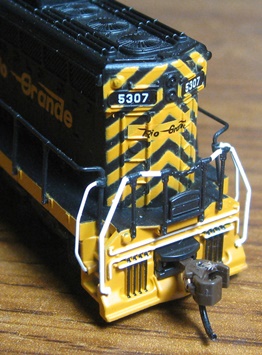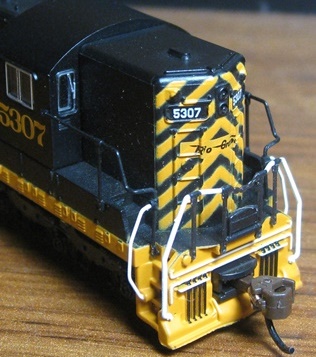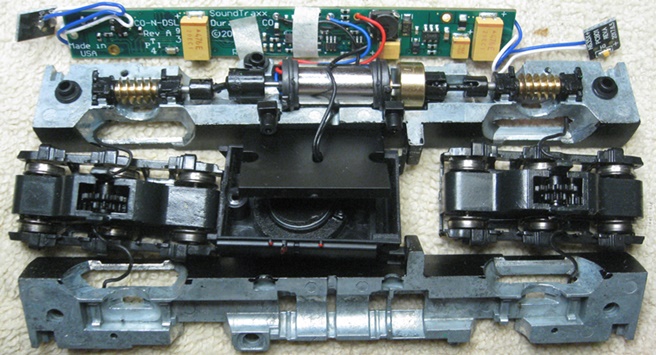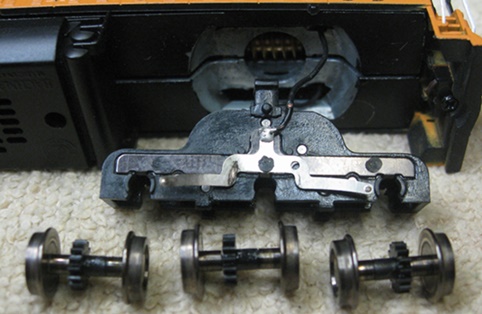

Introduced: 2018
These models are marketed under Bachmann's "DCC Sound Value" line. As such, they all come equipped with a factory-installed SoundTraxx Economi DCC-Sound decoder. Said decoders are "dual mode" (IE, designed to operate equally well on both DCC and analog layouts).
Paint and detailing are very nice -



The chassis is all metal and split-frame. All twelve wheels provide pickup (wheelback wipers are used on the outer wheelsets and axle wipers on the center ones). Each truck has two wires that conduct current to the chassis (soldered to the wheel-wipers on one end and to metal rings that screw to the chassis on the other). The decoder is screwed to two metal posts on top of the chassis (from which it receives track current). Wires from the decoder transfer current to the motor and to the speaker (which is mounted inside the fuel tank). Additional wires transfer current to the headlight and reverse light LED boards which seat loosely in slots on either end of the chassis (the LED boards also provide lighting for the numberboards).

The motor is a round can (and presumably from the same family of coreless motors that Bachmann has been using in their other locomotives of similar vintage). Only one of the motorshafts is equipped with a flywheel. Plastic driveshafts interconnected with U-joints spin the wormshafts. The brass worms are held in place by bearing blocks that mount inside of notches in the chassis.

All six axles are geared and all gearing is black plastic. Clips on the truck towers hold the trucks to the chassis (and although the trucks pull off quite readily, the pickup wires won't let you move them very far). As delivered, the gearing is rather heavily lubricated (or at least it was on my two examples).

The speaker is round and appears to be glued in place inside the plastic fuel tank (with the sound projecting downward through holes in said fuel tank). The fuel tank is screwed to the bottom of the chassis. The wheels are blackened and low-profile (no problems on Atlas Code-55 rails). There are no traction tires. Mine consistantly derails on 9.75"-radius curves, so 11" looks to be the minimum.

The shell is all plastic and consists of two main pieces (cab and body/sidesill) that clip together. Additional press-fit details include handrails, windows (w/ wipers), numberboards, dynamic brakes, winterization hatch, horns, etc. Couplers are shell-mounted E-Z Mates (ala carte Rapido-style couplers are included in the box).

Out of the box, my two test locos were very pokey runners (like yard switcher slow). However, things did eventually become more normalized after several hours of break-in running. Another "as delivered" issue I ran into with one of mine was excessive lubrication inside the trucks (oil all over the axles and the wheelbacks and the wipers), and with the end result being a lot of stuttering and stalling. Fortunately, disassembling the trucks and cleaning off all the lube spew solved that problem for me.
Once properly broken in (and/or cleaned up) these are still only "just OK" in the performance department. On the plus side, pulling power seems adequate (albeit unspectacular), with mine able to handle around 25 assorted 50' freight cars through curves on level track. On the down side, they're not particularly smooth runners. I'm not sure what the deal is there, but something on the inside just isn't meshing together quite right (and with the end result being just a bit of instability and herky-jerkiness as it rolls along). They're not particularly quiet runners either (being a bit buzzy/grindy sounding) which may also be a consequence of whatever is causing the uneven running. Unfortunately, the speaker is not particularly robust (even with the master volume turned all the way up) and once you move out of the low end of the throttle (speed step 7 or higher), the locomotive actually starts to drown out its own speaker.
Now, I suppose it's possible that some of these running issues will go away with time. However, I ran mine for the better part of three days and things didn't seem to improve to any significant degree. So, although I wouldn't categorize any of the performance issues as dire, they're certainly noteworthy enough to drop these models down into the "B" category here (IE useable but not optimal). I suppose the noise issue would be less of a concern if we were talking about a $40 analog locomotive. But since we're not, it may be a dealbreaker for some (considering the premium prices charged for DCC-Sound).
Here's what Bachmann has to say about them -
With its six axles providing a smoother ride, the EMD SD9 proved popular with a variety of railroads. Manufactured in the mid-to-late 1950s, some are still running today on tourist lines. Bachmann's model comes with an Econami SoundTraxx DCC sound decoder. Factory set for EMD SD9 realism, the diesel package also offers a choice of 5 prime movers, 16 airhorns, multiple variations of 7 bell types, 2 air compressors, and 3 couplers plus a function-activated grade-crossing signal - all in 16-bit polyphonic sound. Econami includes adjustable auto-notching sensitivity for prototypical operation, adjustable master volume and individual sound effect volume levels, advanced consisting, and more.
Features -
- DCC sound-equipped with Econami decoder
- Dual-mode NMRA-compliant decoder
- Directional dimming headlights
- Precision motor
- Flywheel
- Die-cast frame
- Fine-scale handrails
- E-Z Mate Mark II couplers, front and rear
Shell removal -
The shell is held to the chassis by friction only (four bumps in the chassis insert into indentations in the shell). To remove the shell, simply insert a small screwdriver between the sidesill and chassis and then pry upwards until all the bumps are freed up. At that point the shell should slide up and off.
Grade: B